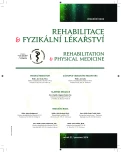The Possibilities of Using Incremental Shuttle Walk Test in Clinical Practice and Clinical Research in Patient with Respiratory Dysfunction
Authors:
K. Neumannová 1,2; Z. Svoboda 1; Z. Kováčiková 1; J. Zatloukal 3; M. Procházková 1,2; M. Janura 1
Authors‘ workplace:
Katedra přírodních věd v kinantropologii, Fakulta tělesné kultury, Univerzita Palackého, Olomouc, vedoucí katedry prof. RNDr. M. Janura, Dr.
1; Katedra fyzioterapie, Fakulta tělesné kultury, Univerzita Palackého, Olomouc, vedoucí katedry prof. MUDr. J. Opavský, CSc.
2; Pulmonary/Cardiac Rehabilitation Department, University Hospitals of Leicester NHS Trust, Glenfield Hospital, Leicester, Spojené Království, vedoucí Pulmonary/Cardiac Rehabilitation Department: prof. S. J. Singh, Ph. D.
3
Published in:
Rehabil. fyz. Lék., 21, 2014, No. 4, pp. 194-198.
Category:
Original Papers
Overview
Respiratory dysfunction often decreases the quality of life in patients with breathing disorders. Respiratory symptoms, especially various degree of breathing difficulties, negatively influence activities of daily living. Walking is one of the most common activities, which is negatively affected by respiratory problems. Therefore, it is very important to focus not only on the evaluation of breathing motion and breathing pattern during the kinesiology testing, but also to assess the presence or absence of gait disorders. We can use the walking tests – the Six-minute Walk Test and the Incremental Shuttle Walk Test, during which it is possible to evaluate the exercise tolerance and individual gait characteristics and parameters. When using these two tests together with kinematic and dynamic gait analysis we can obtain more detailed data. The results of the initial assessment are used to determine the rehabilitation plan, which is focused on the minimization or elimination of the patient’s subjective symptoms.
Keywords:
walking, clinical exercise testing, kinematic and dynamic gait analysis
Sources
1. ATS: ATS statement. Guidelines for the six-minute walk test. American Journal of Respiratory and Critical Care Medicine, 166, 2002, s. 111-117.
2. CASAS, A., VILARO, J., RABINOVICH, R., MAYER, A., BARBERA, J. A., RODRIGUEZ-ROISIN, R., ROCA, J.: Encouraged 6-min walking test indicates maximum sustainable exercise in COPD patients. Chest, 128, 2005, s. 55-61.
3. CHETTA, A., PISI, G., AIELLO, M., TZANI, P., OLIVIERI, D.: The walking capacity assessment in the respiratory patient. Respiration, 77, 2009, s. 361-367.
4. JANURA, M., VAŘEKA, I., LEHNERT, M., SVOBODA, Z. a kol.: Metody biomechanické analýzy pohybu. Olomouc, Univerzita Palackého, 2012.
5. KOBLÍŽEK, V., CHLUMSKÝ, J., ZINDR, V., NEUMANNOVÁ, K., ZATLOUKAL, J., KOCIÁNOVÁ, J., ZATLOUKAL, J., SEDLÁK, V.: Doporučený postup diagnostiky a léčby CHOPN, Praha, Maxdorf, 2013.
6. SINGH, S. J., JONES, P. W., EVANS, R., MORGAN, M. D.: Minimum clinically important improvement for the incremental shuttle walking test. Thorax, 63, 2008, s. 775-777.
7. SINGH, S. J., MORGAN, M. D. L., HARDMAN, A. E., ROWE, C., BARDSLEY, P. A.: Comparison of oxygen uptake during a conventional treadmill test and the shuttle walking test in chronic airway limitation. European Respiratory Journal, 7, 1994, s. 2016-2020.
8. SINGH, S. J., MORGAN, M. D. L., SCOTT, S., WALTERS, D., HARDMANN, A. E.: Development of a shuttle walking test of disability in patients with chronic airways obstruction. Thorax, 47, 1992, s. 1019-1024.
9. SPRUIT, M. A. et al.: An official American Thoracic Society/European Respiratory Society statement: Key concepts and advances in pulmonary rehabilitation. American Journal of Respiratory and Critical Care Medicine, 2013, 188, s. e13-e64.
10. WASSERMAN, K., HANSEN, J. E., SUE, D. Y., STRINGER, W. W., SEITSEMA, K. E., SUN, X., WHIPP, B. J.: Principles of exercise testing and interpretation (5. vyd.). Philadelphia, Lippincott Williams &Wilkins, 2012.
Labels
Physiotherapist, university degree Rehabilitation Sports medicineArticle was published in
Rehabilitation & Physical Medicine

2014 Issue 4
- Hope Awakens with Early Diagnosis of Parkinson's Disease Based on Skin Odor
- Deep stimulation of the globus pallidus improved clinical symptoms in a patient with refractory parkinsonism and genetic mutation
Most read in this issue
- Shoulder in Epitome – Second Part
- Concept of Castillo Morales® v Theory and Practice
- Paresis of Nervus Thoracicus Longus after Resection of the Right Rib in the Thoracic Outlet Syndrome
- Czech Version of the Neck Disability Index and its Application in Patients with Neck Pain
